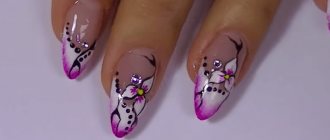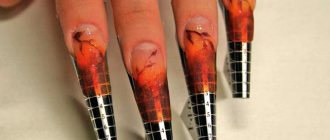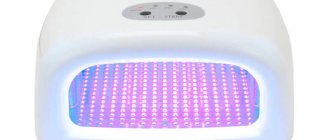Those who like to experiment with manicure are often interested in the question of whether it is possible to apply regular polish to gel polish and whether it will stick. The experts give a clear answer - you should refrain from such experiments, since the products have completely different compositions and adhere differently to the nails. However, many follow the rule: if you can’t, but really want to, then you can. Therefore, we will consider options for how to apply regular polish to gel polish and whether it is possible to make the manicure last a long time.
Gentle manicure
How to apply gel polish
Some girls are interested in whether shellac can be coated with gel so that the effect lasts longer, but there is no definite answer to this question.
The key to long-lasting shellac service is compliance with application technology.
- First, you need to avoid contact with oils and creams. From one slightest drop, the surface of the coating will become uneven and crack in the near future.
- Nails, previously degreased with a special solution, are covered with a base layer of shellac and dried under ultraviolet light for 2 minutes.
- Then cover the nails with a colored layer. After this, it is necessary to repeat drying under the lamp.
- At the end of the procedure, another layer is applied. Excess varnish is removed.
How to care for extended nails (gel, acrylic)
It should be remembered that housework: laundry, cleaning, washing dishes and floors is the reason why nails can be damaged. Of course, a modern woman is unlikely to be able to avoid such work. It will also not be possible to refrain from contact with chemicals contained in detergents.
To avoid damage to the extension plate, you should wear gloves before starting any household work. They are able to protect not only nails from destruction, but also the skin of the hands from drying out and cracking, and even the appearance of allergies.
In addition, upon completion of work, hands and nails should be thoroughly washed with running water and soap and moisturizer should be applied to them.
What happens if you cover regular varnish with topcoat?
Those who, ignoring the warnings and recommendations of nail technicians, nevertheless decided on a non-standard combination, need to know what will happen if a top coat is applied to a regular polish. There are several options:
- The coating will come together like an accordion during the drying stage in the lamp.
- Within a few days the manicure will peel off.
- The coating will last for some time, but no more than a week.
The latter scenario is possible provided that the recommendations for creating an unconventional design are followed.
Attention! Nail technicians claim that such experiments cause significant harm to the nail plate. After unsuccessful attempts, the nails split, break, change color, and sometimes tubercles appear on them. Before attempting to combine incompatible cosmetic products, you need to weigh the risks and the expected benefits of the result.
Other types of manicure techniques with a combination of heterogeneous cosmetic products are presented in the video.
What is the nail extension procedure?
Extensions are a painless cosmetic procedure that allows you to place beautiful artificial nails on top of your own brittle ones.

The extension process is carried out in two ways: gel and acrylic.
Acrylic nails are more durable and resistant to external mechanical influences. They are able to break less and retain their original appearance longer. However, their base - acrylic - can cause allergies and has a specific odor. In addition, without varnish applied to them, they look less natural because they do not have the shine characteristic of real nails.
Gel nail extensions, on the contrary, give a look that is as close as possible to the appearance of a natural nail plate. Sometimes it’s even difficult to distinguish which ones are natural and which ones are artificial – gel ones. This type of extension also has its downsides. These nails are less durable than acrylic nails and therefore require more frequent adjustments and replacements.
Photo of nail polish coating
– the most popular coating used for nail design today. Thanks to its unique composition, shellac manicure combines the best qualities that will help you not only keep your nails well-groomed for a long time after the procedure, but also help them become significantly stronger.
Why is shellac the best nail coating?
- Stays on nails for a long time;
- Allows you to grow your own nails;
- Strengthens the nail plate;
- Gives nails a glossy shine;
- The composition of shellac contains a smaller amount of aggressive substances than the composition of gel polish;
- Shellac nail design allows you to use a huge palette of colors.
You can learn more about what shellac coating is and what rules exist for its application here.
A shellac manicure will last on your nails for one to two weeks (less often two or three). Then you need to remove the varnish and apply a new layer if desired.
Shellac application process
In general, the process of applying shellac to extended nails is no different from applying it to natural nails. Although there has long been a debate among manicure lovers about whether it is possible to paint gel nail extensions with shellac without using a base. Some argue that this does not affect the quality of the coating, while its thickness is reduced. Gel polish is applied as follows:

Acrylic nail polish
- Go over your nails with a delicate polishing buff;
- Degrease the surface. There is no need to use a primer;
- Apply base and cure;
- Apply the first color layer and cure;
- If necessary, apply a second coat of color and cure;
- Apply and dry top coat.
Try to make each layer as thin as possible. After each session under a UV lamp, it is necessary to clean the nail from the sticky layer, if the gel you choose forms it. It is impossible to remove shellac from gel nails. In essence, shellac is the same gel, and therefore if you try to dissolve it and remove it, the plate itself will dissolve along with it.
[yandex3] [google3]
Applying varnish to other surfaces
Varnishing, as a process of creating a protective layer, is also used on other surfaces. It can be metal, plywood, paper, self-adhesive film. Is it possible to coat the film with varnish?
It is possible if there is a need for it. The main thing is not to make a mistake with the varnish, so as not to damage the top decorative layer of the film and prevent the surface from cracking after drying. For example, nitro varnish, for all its advantages, has significant limitations on its use, but acrylic varnish is a more universal product.

What happens if you paint your extended nails? - this question worries many girls who have had their nails done in a salon. The design made on extended nails by a master soon becomes boring; you want something new and fresh.
Nail extensions have become fashionable not so long ago. For many, this procedure is not just a tribute to fashion trends, but also convenience: there is no need to suffer and grow your nails, if you can simply extend them and then remove them, if desired.
Most often, nails are extended either with acrylic or gel. Each of these types of nails requires special care. The fact that after the extension procedure you need to use gloves during housework and make regular corrections is clear to everyone. Is it possible to varnish extended nails without spoiling their appearance?
Yes, you can. Only here there are rules. For example, for gel nails you can choose any varnish you like, but the liquid to remove it should not contain acetone. Acetone makes gel nails feel rough to the touch and can quickly deteriorate. Therefore, to remove polish from gel nails, it is better to buy oil or another product that does not contain acetone.
The same applies to acrylic nails. You can paint them with any varnish, but there are several nuances. Extended nails need to be prepared for polish. This is done like this: first you need to file your nails, clean them, apply a base, and then cover them with a layer of varnish and fix the effect. A base coat is needed to ensure that the varnish does not eat into the artificial nail and change its color.
Almost the same thing is done with “native” nails during manicure. The advantage is that if ordinary nails “hold” a manicure for two to three days, then extended nails painted with varnish will please the eye for at least two weeks.

Extended nails manicured in the “craquelure” style will look very impressive. For this nail design you will need a special varnish - crack, a base and a varnish fixer.
There are two options for creating nail art with “cracks”. First: apply both base and varnish, and then draw cracks with a special stick or thin needle. But this takes a lot of time and effort if you have no experience in this technique.
Suitable for acrylic and gel nails and sand effect varnishes. They can be applied in the same way as on regular nails.
Therefore, another method is preferable: buy a varnish that will “crack” itself as it dries on your nails. To make the effect even stronger, a similar varnish - krake - can be applied in several layers. Just don’t forget about the harmonious color scheme that should end up on your nails during your next experiment.
If you don’t want to paint with varnish, then acrylic-based paints will come to the rescue in nail art for artificial nails.
Unlike traditional varnishes, paints do not crack or chip; they are easy to wash off with water if suddenly some stroke or the color of the paint itself is not suitable. In addition, such paints are not harmful to health.
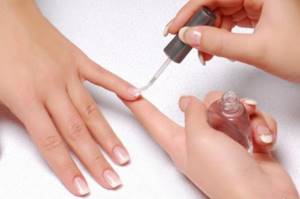
How to paint extended nails with acrylic paints? It's not that difficult. It is important to have everything you need for complete nail art: brushes of different sizes, rhinestones, stickers, base coat for artificial nails,
Before you paint acrylic or gel nails, you need to carefully think about what kind of picture you want to get in the end. The fact is that acrylic paints differ from each other in terms of their pigment saturation and are divided into four categories: transparent, translucent, viscous and opaque. To try out a variety of options, you can dilute paints of different categories with water and mix them together.
There are special techniques for designing acrylic nails. For example, watercolor assumes that it is the drawing that will stand out against the general background. Before applying it to the nail, the plate must be primed. After the primer layer has dried, paint is taken and a picture is drawn on the nail. The resulting result is fixed with colorless varnish.
There is also glazing, which you can do yourself is also not difficult. This technique is performed with pastel varnishes, which are applied layer by layer.
Painting extended nails is easy, but they also require maintenance. To ensure that acrylic or gel nails are always in good condition, you need to regularly make corrections in the salon, use only high-quality cuticle care products and do not use your nails as a screwdriver.
Also, experts do not recommend using varnishes if this happens after swimming. The varnish creates an impenetrable film under the nail, which can result in the formation of mold on the nail. Therefore, on the beach, it is better to paint your nails before diving into the sea or lake. This will avoid premature removal of artificial nails and fungal diseases of the nail plate.

The right choice of varnish, means for removing it and caring for extended nails will always allow you to create a beautiful and fashionable manicure.
You can and even need to paint your extended nails in order to keep up with fashion and experiment with nail designs. Both regular varnish and acrylic paints are suitable for this. But don’t forget about proper care for your extended nails.
Fashion trends
And at the end - a surprise. Let's reveal the secret - what 2018 will bring to the world of beauty and nail design:
- shape of the year - almond, medium-length oval. The color of the year is beige, black, but not only. Example – painting, roses on a black oval;
- The delightful South Korean novelty stunned me - a manicure with a gold wire border is always in trend;
- “glass” manicure, reminiscent of broken glass (that’s what they call it) or the facets of a diamond;
- a fashionable matte manicure decorated with a glossy pattern, for example, a drop, a pea, a leaf, a strip, is at the peak of popularity this year;
- Chameleon polish is still in trend. This is a thermovarnish that constantly changes shades - depending on the temperature of the air, the hand, and the lighting. This opens up some fantastic options for playing with color;
- artistic painting of nails is now applied to the very edges of them, and the subject of painting can be flowers, hieroglyphs, geometric patterns;
- drawing on stone is a fashionable novelty. Agate, malachite, turquoise, onyx, magical drawings - who can resist here.
As they say, we only live once. This means that you want to experience and try everything. And our nails are another artist’s canvas.
Ombre
Designers are creating coats and cardigans where similar transitions are used, hairdressers are improving their coloring of curls, and manicurists are improving their nail design. It’s easy to create at home and choose bright, rich colors for spring and summer, and a calm, warm palette for autumn-winter. The gradient is made like this:
- first you need to prepare a tool, it can be a piece of foam sponge or a cosmetic sponge, the second one is more suitable as it has a denser structure;
- then you need to choose 2-3 varnishes of a suitable range, that is, the transition should be smooth, for example, if the base is red, you can take lemon and orange, for blue - pale pink and purple, it is worth remembering that the free edge always remains helium, it should be either the lightest or darkest in the composition;
- apply regular varnish in strips to the foam rubber, print first on paper to remove excess;
- then transfer to the nail plate, leaving a distance of several millimeters from the free edge uncovered;
- when pressed repeatedly, the borders of the stripes shade themselves;
- clean blots from the skin and cuticles; for this it is convenient to use a cotton swab soaked in removing liquid;
- wait 20-25 minutes until the regular varnish dries;
- then treat with top coat and cure for 1-2 minutes in a lamp.

Read more in our article “How to make ombre nails with gel polish?”.
When you're tired of everything
If the desire to change the design is great, then the process of removing gel polish will not scare you. It’s already been said above that you can’t remove it with acetone, or with a file, just to rip it off is even more barbaric. Is there anything else I can do to remove gel polish from extended nails?
A few recommendations on this issue:
- removal with remover. The solvents are gentle and contain vitamins and minerals. The method is fast, effective, safe;
- removal using a special device (milling cutter) with different attachments (cutters). In the experienced hands of a specialist, this is a quick, effective procedure. You can learn how to use a router at home and remove gel polish easily, without discomfort, saving on salon services;
- the third method is not very useful for nails. But if there is nothing else to remove the gel polish with, you can use alcohol diluted with water (1:1) or 100% vodka as a solvent. The exposure time should be increased to 20-30 minutes.
Tags
cover nails with gel for nails extended nails nails gel nails paint Simple nails with gel nails usually Nail extensions For nail extensions a type of nail extensions type of extension prevents Nail extensions Nail extensions manicure from manicure. DIY manicure or for manicure. fashionable manicure Features of manicure on
extensionacrylicnailphotobeautifulcarelookbestfashionseasonanswerfrenchrhinestonesenoughdodojustquestionsnewhelpshorthairbasewhitetwowhichpopularwhatmaterialstrendsmaterialnailsnaturalremovalstylepaintbrushesnailshapeedgefree
When you're tired of everything
If the desire to change the design is great, then the process of removing gel polish will not scare you. It’s already been said above that you can’t remove it with acetone, or with a file, just to rip it off is even more barbaric. Is there anything else I can do to remove gel polish from extended nails?
A few recommendations on this issue:
- removal with remover. The solvents are gentle and contain vitamins and minerals. The method is fast, effective, safe;
- removal using a special device (milling cutter) with different attachments (cutters). In the experienced hands of a specialist, this is a quick, effective procedure. You can learn how to use a router at home and remove gel polish easily, without discomfort, saving on salon services;
- the third method is not very useful for nails. But if there is nothing else to remove the gel polish with, you can use alcohol diluted with water (1:1) or 100% vodka as a solvent. The exposure time should be increased to 20-30 minutes.
Regular varnish vs shellac
Experiments on combining regular varnish and shellac have shown that the effect is the same as if you do not degrease the nail plate before starting the procedure. The reason for the incompatibility is the oils that are present in the varnish and different textures. The shellac surface allows the nail to maintain a healthy appearance, and the impenetrable layer of standard varnish blocks air access. If you save money and cover a shellac-based manicure with classic varnish, then after a couple of days it will begin to crack and crumble.

Many people doubt whether regular varnish can be coated with shellac topcoat. Yes, experts do this if they use it as a decorative element. The varnish is applied and then covered with a final sealing layer. In this case, you need to carefully consider the choice of manufacturer and composition.

Composition of acrylic varnish
Acrylic varnishes have the safest composition.
The content of harmful substances, formaldehydes and toluenes, as well as dangerous plasticizers such as dibutyl phthalate and camphor, which make the varnish film elastic and durable, is minimized or completely absent.
The basis of acrylic varnishes is water and acrylic emulsion, highly soluble in water. Sometimes acrylic emulsion is replaced with acrylic powder, which gives the nails shine and has a brighter palette.
Do not miss
- Do not miss
Be your own master: how to strengthen your nails with acrylic powder
What types can be
Plates are distinguished according to different parameters, the main one being material. The following tips are considered the most popular.
Made from nylon
It is well modeled and follows the shape of a natural nail, ideal for professional nail art.
From polyflex
This material allows the pad to be flexible and provides adhesion to other polymers. Thanks to the composition of polyflex, the design and decoration of nails, like the tips themselves, will not peel off.
Made of plastic
Modern manufacturers of high-quality linings add substances to the usual plastic tips that can reliably adhere the plate to other polymers. At the moment, plastic tips are the most popular among nail artists.
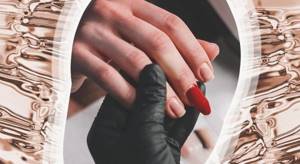
In addition to the characteristics of the material, tips also differ in shape. Classic onlays are curved, follow the natural shape of the nail and are suitable for most nails that have not previously been injured. Stiletto overlays are most often used for designs or as the basis for another shape, as we noted above. And to create a French manicure, masters often use straight tips without a contact zone. This means that the overlays are not glued to the nail, but are attached to it end-to-end.
Another category by which tips are distinguished is the color base. Most often they prefer transparent overlays that can be painted in any shade. Nude base plates are used to avoid additional camouflage.
Colored tips significantly reduce the time spent in the salon, but working with them requires knowledge of the technology and basics of manicure with overlays. Therefore, it is better not to do them for novice masters. There are also options with ready-made French: on such plates the ideal light line is already prepared in advance.






